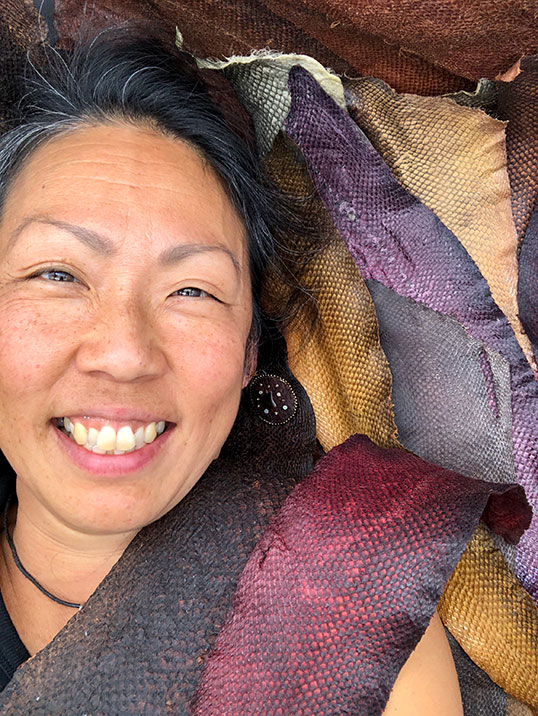The Museum of Vancouver (MOV) is offering a two-part online workshop by local artist, maker and educator Janey Chang about fish skin tanning on Feb. 20 and Feb. 27.
Fish skin tanning is a process of turning raw fish skins into beautiful and durable textiles that can be used to make anything one would use leather for, such as clothing, footwear, wallets, pouches and even jewelry.
“Tanning is the process of adding substances, tanning acids specifically, to the fish skin; it is actually a way to preserve the skin. The tanning acid binds to the threads of what make up the skin, making it thicker, bulkier, stronger and long-lasting,” Chang explains.

A bag made of tanned fish skin. | Photo by Janey Chang
Chang first learned the craft years ago at an ancestral skills gathering in the United States and gradually developed her own techniques through continuous learning and experimenting over the years. Her workshop will mainly focus on tea tanning techniques, but she says one can also use bark or oil to tan the fish skin.
The origin of fish tanning can be traced back to many different parts of the world: Japan, China, Scandinavian countries, Indigenous people of Alaska and Canada. However, wherever it is practiced around the world, Chang says it is an almost forgotten skill.
“In my work, I have been contacted by a lot of Indigenous groups asking me to teach them, because they have some memories but they don’t know how to do it,” says Chang. “There aren’t a lot of teachers of this skill. For me, I feel really strongly about helping to revive the skill. I have taken my tanning knowledge, trying to expand that and give it back to other communities.”
Chang says many types of fish – salmon, black cod, trout – can be tanned. She usually gets her fish skins from the restaurant industry, which would normally discard them.
“This is also something that I love because I am taking a waste product and making something beautiful, useful and proactive out of it,”
she says.
A sense of connection

Janey Chang revives an ancient tradition practiced around the world. | Photo by Calder Cheverie
Chang has lived many lives before she became an artist and educator. She worked in the corporate world as a legal secretary for a number of years in Toronto before moving back to Vancouver to be more connected to nature. She then worked in the Department of Psychiatry at UBC for a while before going back to school to pursue her passion in outdoor education, where eventually she stumbled upon fish tanning as a calling.
“I really want something that connects on a deeper level, that would also help me to answer the question who am I on this land, when not coming from this land, where is my place in the world and how can I belong here,” she says.
Chang, the first in her Chinese immigrant family to be born in Canada, says she felt a sense of grief growing up not connected to her ancestral culture.
“The work I do is all about transformation; I really struggle as I wasn’t connected to my Chinese culture. I am looking at ways to express myself that I really connect to. It is taking me a long time; fish tanning is a door opener for me. I realize I can feel at home where I am but I can also be connected to old ancestral skills by doing this work. It is something that connects me to both here and there,” Chang says.
She believes tanning is not only a practical skill but a healing skill from the land that deepens one’s relationship with nature.
“The land has power, it has energy – it is so healing. When I can grow deep roots here and know the land around me, then I can reach back to my Chinese ancestry,” shares Chang.
For more information please visit www.museumofvancouver.ca









